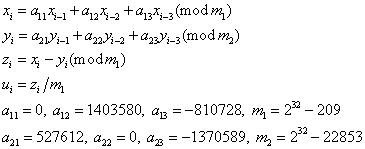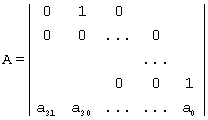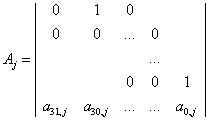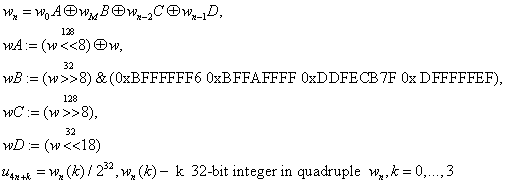Notes for Intel® oneAPI Math Kernel Library Vector Statistics
A newer version of this document is available. Customers should click here to go to the newest version.
Visible to Intel only — GUID: GUID-A9244CDE-22AC-4CAA-BF29-8201FB5CCB47
Visible to Intel only — GUID: GUID-A9244CDE-22AC-4CAA-BF29-8201FB5CCB47
UniformBits (VSL_RNG_METHOD_UNIFORMBITS_STD)
A random number generator of uniform distribution that produces an integer (non-normalized to the interval (0, 1)) sequence. You can identify the underlying BRNG by passing the random stream descriptor stream as a parameter. Then UniformBits function calls integer implementation of this basic generator.
Basic generators differ in bit capacity and structure of the integer output, therefore you should interpret the output integer array of the function viRngUniformBits correctly. The following list provides rules for interpreting 32-bit integer output r[i] for each VS BRNG.
MCG31m1
Integer Recurrence

Interpretation of 32-bit integer output array r[i] after calling viRngUniformBits

R250
Integer Recurrence

Interpretation of 32-bit integer output array r[i] after calling viRngUniformBits

MRG32k3a
Integer Recurrence

Interpretation of 32-bit integer output array r[i] after calling viRngUniformBits

MCG59
Integer Recurrence

Interpretation of 32-bit integer output array r[i] after calling viRngUniformBits

WH
Integer Recurrence

Interpretation of 32-bit integer output array r[i] after calling viRngUniformBits

MT19937
Integer Recurrence



 ,
,
 ,
,
 ,
,
 ,
,
where
 ,
,
with 
 .
.
Interpretation of 32-bit integer output array r[i] after calling viRngUniformBits

MT2203
Integer Recurrence






 ,
,
where
 ,
,
with  ,
,  .
.
Interpretation of 32-bit integer output array r[i] after calling viRngUniformBits

SFMT19937
Integer Recurrence

Interpretation of 32-bit integer output array r[i] after calling viRngUniformBits
r[i] = wi/4(i % 4)
SOBOL
Integer Recurrence

 ,
,
where
 ,
, 
and s is the dimension of quasi-random vector.
Interpretation of 32-bit integer output array r[i] after calling viRngUniformBits

NIEDERR
Integer Recurrence

 ,
,
where
 ,
, 
and s is the dimension of quasi-random vector.
Interpretation of 32-bit integer output array r[i] after calling viRngUniformBits

PHILOX4X32X10
Integer Recurrence
cn = cn-1 + 1
wn = f(cn)
f(c) is computed as follows:

k00 = k0
k10 = k1

f(c)=  , N= 10
, N= 10
Interpretation of 32-bit integer output array r[i] after calling viRngUniformBits
r[i] = wi/4(i % 4)
wi(k) is the k-th 32-bit integer in quadruple wn, k= 0, 1, 2, 3
ARS5
Integer Recurrence
cn = cn-1 + 1
wn = f(cn)
f(c) is computed as follows:
c0 = c xor kand k0 = k
ci+1= SubBytes(c)
ci+1= ShiftRows(ci+1)
ci+1= MixColumns(ci+1), omitted if i + 1 = N
ci+1= AddRoundKey(ci+1,kj)
Lo(ki+1)=Lo(k)+ 0x9E3779B97F4A7C15
Hi(ki+1)= Hi(k)+ 0xBB67AE8584CAA73B
f(c) = cN, N= 5
Interpretation of 32-bit integer output array r[i] after calling viRngUniformBits
r[i] = wi/4(i % 4)
wi(k) is the k-th 32-bit integer in quadruple wn, k= 0, 1, 2, 3
NON-DETERMINISTIC
Integer Recurrence
Non-deterministic random generator [BMT] available in the latest Intel® CPUs [AVX].
Interpretation of 32-bit integer output array r[i] after calling viRngUniformBits

Lo(x) means obtaining lower 32 bits of the 64-bit unsigned integer x, that is, Lo(x) = xmod232.
Hi(x) means obtaining upper 32 bits of the 64-bit unsigned integer x, that is, Hi(x) = ⌊x/232⌋.
ABCD means a 128-bit number composed of four 32-bit numbers A, B, C and D, that is

So, when you generate an integer sequence of n elements, the output array r[i] of the function viRngUniformBits comprises:
n elements for the basic generators MCG31m1, R250, MRG32k3a, MT19937, MT2203, SOBOL, NIEDERR, Philox4x32-10 and ARS5.
2n elements for the basic generator MCG59.
4n elements for the basic generators WH and SFMT19937.
You may use the integer output, in particular, for fast generation of bit vectors. However, in this case some bits (or groups of them) might be non-random. For example, lower bits produced by linear congruential generators are less random than their higher bits. Note that quasi-random numbers are not random at all. Thoroughly check the integer output bits and bit groups for randomness before forming bit vectors from r[i] array.
See Intel® oneAPI Math Kernel Library Vector Statistics Random Number Generator Performance Data for test results summary.